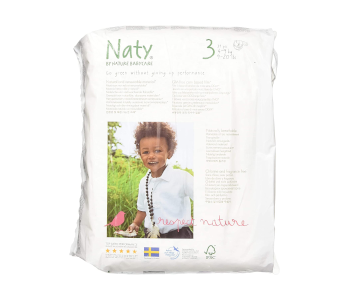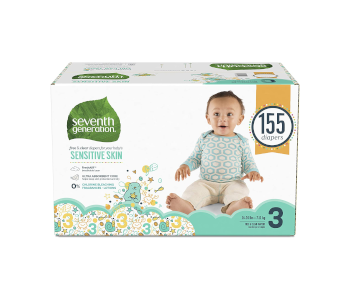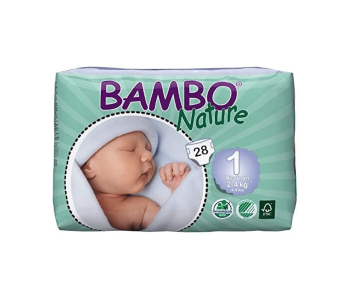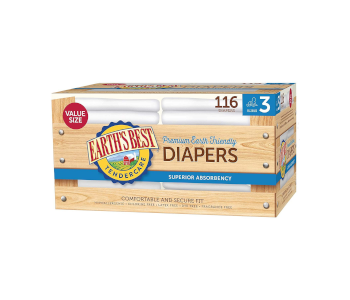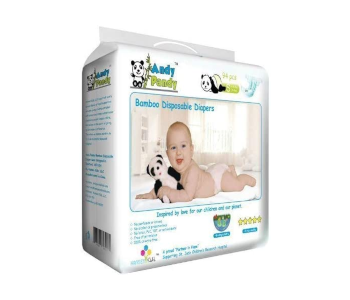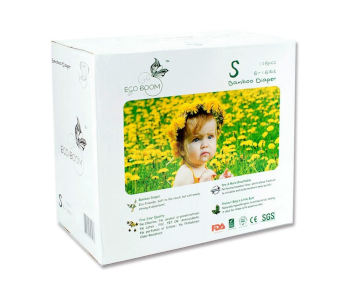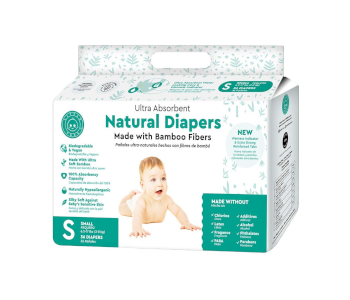An average baby uses up to 7,000 diapers before learning to use the toilet. If you use disposable diapers instead of cloth ones, that’s a lot of diapers that end up in the landfill, and they stay there for decades. That’s right – disposable diapers don’t decompose for decades until you use one of the best biodegradable diapers.
Do you know what’s crazy?
The disposable diapers that you used as a child are still SLOWLY decomposing in a landfill somewhere. That’s why diapers are in the top contributors to landfills. As parents and families become more earth-conscious, more are switching over to the use of biodegradable diapers.
Years ago, those diapers were rough and unpleasant to use on your baby. Parents didn’t want to use them because they felt so uncomfortable on their babies, but manufacturers now create biodegradable, earth-friendly diapers that feel as soft as conventional ones.
Let’s take a look at some choices families have for biodegradable diapers.
A Quick Peak
Need to jump forward?
Nature Babycare Diapers – The Best Overall
Seventh Generation Baby Diapers – Easiest to Find in Stores
Bambo Nature Eco-Friendly Baby Diapers – Best Bamboo Diapers
Earth’s Best TenderCare Diapers – Best Known Choice
Andy Pandy Bamboo Diapers – Newest on the Market
Eco Boom Baby Diapers – Softest for Your Baby’s Bottom
Little Toes Natural Diapers – Fastest Decomposition Rate
Why You Should Consider Using Biodegradable Diapers
Did you know that an estimated 20 BILLION disposable diapers end up in the landfill each year? That creates around 3.5 million TONS of waste each year.
That’s a lot of diapers, and the EPA is concerned about the environmental impact disposable diapers have on our land and water sources. Experts worry that pathogens from the diapers could contaminate local water sources, polluting drinking water for humans and animals.
Not only is the concern about contaminating local water sources, but disposable diapers take close to 500 years to decompose fully – or so we think. The oldest disposable diaper is only about 70-80 years old, so the very first prototypes are still in a landfill somewhere.
Gross.
You might not realize that parents are supposed to dump any solid waste into the trash can, but most don’t do so. That adds more waste to contaminate groundwater. Feces carry viruses that can leak into local water supplies.
Let’s not forget that many disposable diapers use chemicals that can cause allergic reactions. Diapers contain dyes, dioxins, and other things that you don’t want to use near your baby.
How to Pick the Best Biodegradable Diapers
Luckily, the eco-friendly world continues to expand regularly, so parents continue to have more choices. However, more options make it harder to decide which diaper is the best one for your child.
Like anything else, no one brand works for everyone. Some babies will react even if biodegradable diapers or some will have a fit that doesn’t work for your baby’s body.
So, you need to look at how to pick the right diaper for your baby. Let’s take a look!
Chemical Free
When you decide to use a biodegradable diaper, one of the bonuses is that they tend to have fewer toxic chemicals used to create it. That means less damage to the environment.
Make sure that the diaper you pick has these chemicals left out of its components.
- Chlorine
- Dyes
- Perfumes
- Latex
- Dioxins
- Phthalates
How Well It Functions
Ultimately, the most essential part of any diaper is ensuring it functions properly.
What do I mean by functioning? Diapers need to hold in urine and feces – the primary purpose of a diaper!
It can be hard to determine this without using the diaper first. So, I suggest that you look at the reviews left by parents to see what others think. It’s also a good idea to talk to your friends to find out if anyone tried that brand and ask what they thought of it.
Priced Right
No matter who you are, the price of the diapers that you pick matters. Eco-friendly diapers do tend to cost more money than the diapers created with more chemicals. While that seems counterintuitive, it’s reality.
Only you can decide a price range that you feel comfortable spending. Pick your budget and see what fits into it best rather than the other way around. There are diapers for all ranges.
Is It Really Biodegradable?
The FDA doesn’t regulate terms such as “biodegradable,” so that means any company can claim its product degrades faster, but they don’t need to show proof to back up their claims to use this word.
On most of these diapers, you can find somewhere (usually in small print) how biodegradable it is. Not all diapers are 100% biodegradable. Some might be 75%. As a comparison, a conventional diaper is only about 25-30% biodegradable.
While 100% is ideal, it might not be in your price range, so pick one that is as close to 100% as possible.
The Parts of a Disposable Diaper – You Should Know!
Since you do care and want to pick the right diaper for your baby, it’s essential to consider the parts and materials used in a diaper. Some diaper brands are transparent and share the components of their diapers. If you want to know, you should have the right to know, but not all companies like to share their ingredient list.
Let’s look at the parts of a diaper – we can call it the anatomy of a diaper. Let the dissection begin!
Inner Layer
Often called the top sheet, the inner layer is the part of the diaper that touches your baby’s skin. For most babies, if they react, it’s due to the chemicals in this part of the diaper. Babies with sensitive skin often react to diapers that use lotion or artificial fragrances.
Unfortunately, the inner layer is the one that most companies fail to tell parents what it contains. They like to keep it secret – but secrets can lead to diaper rashes and reactions.
The Core
Who wants a diaper that leaks? No one!
The core is the absorbent part of the diaper that holds in the urine. Ideally, the materials used will contain in the liquids rather than squeeze them back out onto your child’s skin. As you might imagine, that can be uncomfortable for your baby.
Some companies use something called SAP to soak up the urine, trapping it in the core. If you squeeze a dry diaper, you’ll feel beads in the core. That is SAP, and the fluffy material around it is typically wood pulp. SAP is controversial, and we’ll discuss that shortly. Some companies rely on a mixture of wheat or corn-based materials to spread the urine across the entire diaper.
Waterproof Outer Shell
The last, but certainly important, component of a diaper is the waterproof outer shell. Without this shell, the urine would leak all over the place, soaking clothes and furniture.
The outer shell typically contains petroleum-based plastic or plastic treated materials, but you probably know that petroleum is controversial as well and not considered eco-friendly. Eco-friendly diapers often use a plant-based plastic to create the coating.
You Should Know – SAP is Controversial
We mentioned SAP a few moments ago, but it’s an important topic that you should understand before picking a diaper for your baby. SAP is the magical secret to the success of disposable diapers, but it comes with controversial issues.
SAP stands for super absorbent polymer, and it’s the little beads or crystals located inside a diaper’s core. The beads hold and absorb the urine. It sounds great, so why is this ingredient considered controversial and shunned by many parents? Here’s why.
- It’s a relatively new material, developed in the mid-1980s. That means there haven’t been any long-term tests to determine its safety and any side effects.
- Companies have failed to complete enough testing to prove to parents that SAP is non-toxic and safe for your child. While your child won’t be eating the diaper – hopefully – the skin is still our largest organ, and it absorbs whatever it touches. That means your baby’s bottom, which is close to the reproductive organs, absorb any of those nasty and potentially dangerous chemicals.
- We know that SAP is derived from petroleum, which is also a chemical part of diapers that are not considered safe for kids.
- SAP has been linked to toxic shock syndrome.
Why You Should Avoid Dyes, Fragrances, and Lotions
You’ll see a lot of hype surrounding these three ingredients, and it might leave you wondering why they’re so important to avoid. Here are some things to consider.
Dyes are a primary culprit when it comes to allergic reactions because they contain toxic chemicals and heavy metals. Some companies use pigment and safe inks rather than dyes, and those are acceptable.
● Why does a diaper need any color? They just end up in the trash anyway!
When it comes to fragrances, I’ll never forget when I purchased Luvs for my oldest child. Everyone told me how wonderful they worked, but as soon as I changed her, all I could smell was the heavy fragrances. They were nauseating.
Companies add fragrances to help mask the scent of feces and urine, but perfumes are made with synthetic chemicals that can cause allergic reactions. If your child has allergies or asthma, artificial fragrances can be triggering as well, leading to breathing problems.
● Guys, let’s be honest – diapers will stink. Stay away from fragrances. If you get a fragranced diaper, you’ll end up smelling poop with perfume. It’s not an enjoyable scent either way.
Now, how can lotion be bad?
The problem with adding lotion to diapers is that you have no idea what the companies used or the ingredients to the lotion. That means some babies can and do have reactions to diapers that have added lotion.
Companies add lotion to the inner layer of the diaper that touches your baby’s skin. Most creams are petroleum-based, and there is no need to add lotion. Disposable diapers function fine without adding a moisturizer to the mix.
The 7 Best Biodegradable Diapers
Now that you know all that you need to know to help you pick the right diaper for your child, we’re going to look at the top picks for the best biodegradable diaper. There are some fantastic options available on the market for your child!
1. Nature Babycare Diapers
Naty diapers are an eco-friendly baby diaper that doesn’t contain any perfumes, plastic, chlorine, or GMOs. Nature Babycare began in Sweden with a focus on creating natural, safe diapers from renewable materials.
Since their start, Naty continues to make their diaper the best that it can be. Some of the reasons that parents and babies alike enjoy these diapers include:
- Naty increased breathability ensures the diaper doesn’t cause diaper rashes.
- The diapers use a film made out of GMO-free corn instead of the typical plastic that helps prevent diaper rashes and ensures the diaper is waterproof.
- The pulp is chlorine-free, harvested with sustainable practices from Scandinavian forests.
Nature Babycare diapers are an excellent pick for your baby. The Swedish Society for Nature Conservation and the Swedish Asthma & Allergy Association certify these diapers, so you know they’re safe for your kids.
The only negative that some parents discuss is that the diapers feel slightly stiff compared to conventional diapers. However, that tends to be a common trade-off when parents want to use biodegradable, natural diapers.
| PROS |
|---|
| Comes in five sizes from 4-60lbs |
| Use a waterproof corn-film instead of plastic. |
| Contains no chlorine, dyes, or fragrances |
| Certified wood pulp center |
| CONS |
|---|
| Feels slightly stiff |
| Not ideal for heavy wetting babies |
2. Seventh Generation Baby Diapers
One problem that many parents have when searching for eco-friendly, biodegradable diapers is finding a choice that they can pick up at a local grocery store. No matter how much you plan, it’s easy to forget to order and run out of diapers if you rely on online deliveries. That’s where Seventh Generation comes into play.
Chances are you recognize the brand name Seventh Generation; they sell everything from baby diapers to laundry soap and dozens of things in between. It’s hard not to love their dedication to creating eco-friendly products for the everyday family.
When it comes to their diapers, there are several things we love about them.
- These diapers are free of fragrances, latex, and lotions.
- We know that Seventh Generation uses no chlorine in their processing, and they don’t whiten their diapers. You’ll notice that they have a natural brown core, created from wood pulp, for top absorption.
That doesn’t mean these diapers are perfect. Unfortunately, you find typical brands in the grocery stores that still typically contain some chemicals that you want to avoid, and Seventh Generation is no exception. Their diapers contain:
- SAP
- Polypropylene
- Adhesives
- Pigments
It’s up to you, as the parent, to decide if you’re comfortable with diapers that contain these chemicals.
| PROS |
|---|
| Easy to find |
| Affordable price |
| Chlorine and fragrance-free |
| Uses wood pulp for the center |
| CONS |
|---|
| Contains petroleum-based ingredients |
| Rough materials |
3. Bambo Nature Eco-Friendly Baby Diapers
Another brand that parents love is Bambo Nature Diapers. If you’re looking for a chemical-free, European-manufactured diaper (which means more regulation than diapers created in the United States), Bambo Nature could be a great choice.
First, let’s look at being chemical-free. Bambo Nature has the Nordic Swan Eco-Label, which might not seem like a big deal, but it is. To get this label, the diapers need to be free of any harmful chemicals. So, we know these diapers are free of:
- Chlorine
- PVC
- Phthalates
- Latex
- Heavy Metals
- Organotins
- Formaldehyde
Bambo Nature diapers are hypoallergenic, free of any chemicals that might irritate your child. This company really pays attention to details! Bambo Nature diapers are free of:
- Optical Brighteners
- Perfumes
- Lotions
- Dyes
- Odor Eliminators
- Essential Oils
That’s not all. This diaper uses wheat starch in the absorbent core instead of SAP, so you’re avoiding extra, unnecessary petroleum in your diapers. Plus, they focus on using an eco-friendly manufacturing process without any use of chemicals.
While Bambo Nature isn’t 100% biodegradable, the company tells us it’s 75% biodegradable, which is better than the typical 35% degradability of conventional diapers. Considering the lack of all dangerous chemicals and additives, I think we can overlook this!
| PROS |
|---|
| Seven available sizes |
| Asthma and allergy-friendly |
| Soft on your baby’s bottom |
| CONS |
|---|
| Pricey |
| Tends to leak |
| Not ideal for overnight |
4. Earth’s Best TenderCare Diapers
Here’s another brand that is well-known in the eco-friendly, organic baby brand world. Earth’s Best is a leader; they were among the first brands to create organic formulas and baby food. After decades, this brand knows what they’re doing.
Here is what you need to know about the TenderCare diapers.
- Their diapers are chlorine-free, crafted with renewable resources.
- Instead of SAP, Earth’s Best uses a combination of wheat and corn for the inner layer and absorbent core.
- The diapers are free of dyes, perfumes, and latex.
- You can buy these diapers in seven sizes, from birth up to potty training.
- All of the sizes have breathable sides to stop leaks while also keeping your baby comfortable. The newborn diapers have stretchy tabs to help the diapers fit the best.
All of this sounds great, but the negative is that Earth’s Best still uses some petrochemicals in their diapers. While they’re safer and more eco-friendly than other brands, they’re not the perfect choice.
| PROS |
|---|
| Affordable |
| Sold in many grocery stores |
| Free of latex, chlorine, fragrance, and dyes |
| Works well for overnight and heavy wetters |
| CONS |
|---|
| Uses petrochemicals still |
| Fit tends to run small. |
5. Andy Pandy Bamboo Diapers
If you want a newer brand on the market, Andy Pandy is making big waves – parents love them! Their diapers are some of the softest and super absorbent because they use bamboo, which is known for being a thirsty fabric.
Andy Pandy is a naturally hypoallergenic, antibacterial diaper that is perfect if your child has sensitive skin. Their diapers stand out because they use biodegradable bamboo, which makes it soft on your baby’s bottom. At the same time, it ensures that the diaper is as strong as possible and super absorbent.
Another reason that parents like these diapers are that they wick moisture away better than most diapers. Bamboo is a material that helps your baby regulate temperature, so it keeps your baby cool and dry, no matter how warm it is outside.
Let’s not forget that these diapers are free of:
- Chlorine
- Alcohol
- Preservative
- Latex
- PVC
| PROS |
|---|
| Absorbent |
| Soft on your baby’s bottom |
| Wicks away moisture |
| Antibacterial |
| Hypoallergenic |
| CONS |
|---|
| Too Expensive |
6. Eco Boom Baby Diapers
If you want an environmentally friendly bamboo diaper, Eco Boom is a great choice. Parents and babies love that these diapers use high-quality bamboo on both the back and top sheets. This helps to wick away moisture, but it also reduces reactions and feels soft against your baby’s bottom.
Eco Boom stands out because they use a core that is total chlorine-free, which is ideal for all babies but especially those with sensitive skin. That’s not all! Here are some of the other reasons why Eco Boom is an excellent biodegradable diaper for your family.
- They don’t use any glue or adhesive that might irritate your baby.
- These diapers don’t contain TBT, PVC, latex, phthalates, preservatives, alcohol, or chlorine.
- The packaging and interior bags are biodegradable within 18 months.
- Eco Boom created a diaper that is naturally hypoallergenic, ideal for all babies.
- For the perfect fit, they added big ear side tape with triple elasticity. That means these diapers are very flexible, which stops them from being too tight on your baby’s weight and won’t cut into their tender skin.
| PROS |
|---|
| Bamboo fibers on the top sheets |
| Pulp is chlorine-free |
| Aloe oil for softness |
| CONS |
|---|
| Might leak |
| Made in China |
7. Little Toes Natural Diapers
Little Toes created a natural, biodegradable, and hypoallergenic diaper that holds in leaks and keeps your baby dry. You can even use these overnight; they’re so absorbent! Best of all, these diapers can decompose in 180 days when sunlight an soil are available.
These diapers are made of bamboo fiber, which is excellent for sensitive skin. These diapers don’t cause skin irritations or rashes, and they’re so soft to the touch. The top and back sheets are naturally breathable, so fresh air keeps your baby dry. Then, the stretchy sides let your baby move freely, and the elastic waistband gives a snug fit that keeps pop explosions inside.
Little Toes diapers are free of:
- Perfumes
- Alcohol
- Phthalates
- Additives
- Latex
- Chlorine
So, what’s the problem? Little Toes uses a core that contains SAP for maximum absorbency and dryness. We do know that SAP is controversial, and ideally, it wouldn’t be used.
| PROS |
|---|
| Hypoallergenic |
| Free of harmful chemicals and additives |
| Snug waistband |
| Stretchy and comfortable |
| CONS |
|---|
| Tabs break easily |
Picking the Best Biodegradable Diaper
Cleaning up our landfills and make a smaller carbon footprint should be a goal for all families. One simple change that parents can make is to pick one of the best biodegradable diapers instead of conventional diapers. You can stop thousands of diapers from sitting in the landfill for centuries to come!

